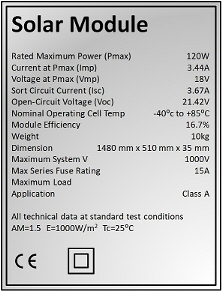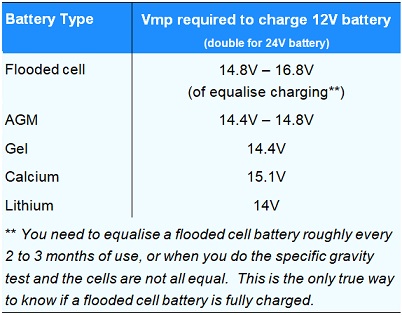Deciphering the back of a solar panel
 Solar panels should have a sticker on the back detailing important information about that panel and those details should be listed in the specifications for the panel. Those specs are particularly important if you're adding to existing panels, as you want your new panel to work with the old.
Solar panels should have a sticker on the back detailing important information about that panel and those details should be listed in the specifications for the panel. Those specs are particularly important if you're adding to existing panels, as you want your new panel to work with the old.
Before we go into those specifications, it's important to know that all those figures are based on standard test conditions and you need to bear in mind that standard test conditions are rarely applicable in the real world.
Standard Test Conditions (STC)
The label on the back of the solar panel should state that the figures listed on that label were obtained under Standard Test Conditions, or STC, and it should also tell you what those standard test conditions are. They are generally the same for every solar panel:
Air Mass (AM) = 1.5
This is the amount of air that radiation from the sun has to pass through. When the sun is directly overhead, the Air Mass is 1. Under Standard Test Conditions, AM = 1.5, which equates to the sun being 48.2 degrees from the vertical.
Solar Irradiance (E) = 1000W/m2
This is the amount of light reaching the solar panel and is measured in watts per square metre. Under Standard Test Conditions, E = 1000W/m2. This also happens to be approximately the amount of solar radiance received at the earth's surface at sea level.
The solar irradiance under which a solar panel is measured is obtained by flashing sun-simulated light from a light box for 5 seconds at 25°C at the equivalent of approximately 48.2 degrees from the vertical.Temperature of the Cell (Tc) =25°C
The temperature that's measured under STC of 25°C is the temperature of the actual photovoltaic cell or module, though how you actually measure this when the cell is sandwiched between glass and the backing escapes us at the moment. Research suggests that this temperature is actually calculated using the temperature of the solar panel backing and a heat flux calculation.
The important thing is that it's not the ambient air temperature - it's the temperature of the inside of the actual solar panel. Obviously the temperature of the panel itself is going to be significantly higher, especially if there is little air movement to dissipate heat. The higher the temperature of the panel, the less voltage it will produce.
Check out Maximising your solar harvest for a graph of how temperature affects solar output.
Now, on to those other figures on the back of a solar panel...
Rated Maximum Power (Pmax)
This is how many watts the solar panel should be able to put out - under standard test conditions. When you're looking for a 150W solar panel, Pmax is the actual number you're looking for.
Voltage Maximum Power (Vmp)
This is the voltage that a solar panel will output under standard test conditions of 25°C. For a 12V panel, this Vmp is generally somewhere between 17V and 18V.
If your existing RV solar panels are connected in series (you will have an MPPT solar controller), or you have only one solar panel and an MPPT solar controller (in which case you will have to connect your additional panel(s)) in series, then it's important to purchase additional panels of the same Vmp as the one you've already got.
TIP: If it's going to be a huge hassle to lift the panel up to see the label on the back, you might be able to squeeze your phone under it to snap a picture of the label.
How Vmp relates to your battery type
Different types of batteries require different amounts of voltage in order for power to flow into the battery. Some examples are listed below:

As you can see, the voltage required for a lithium battery to charge is the lowest of them all. It's also clear that you need a panel that will provide enough voltage to overcome the resistance in your wiring, feed your solar controller (a significant amount if it's an MPPT controller, much less if it's a PWM controller) and still be high enough to flow into your battery.
Bear in mind also that:
- This voltage will travel through cable, which adds resistance. The longer the cable and the thinner the cable, the more resistance and the less voltage you will get at your battery.
- The Vmp decreases as the temperature of the panel increases above 25°C.
- If you have more than one solar panel connected in series, the combined voltage from each panel will flow to your RV solar controller. This means that you're more likely get a voltage that is high enough to charge your battery.
VMP x IMP = Vmax, or advertised watts of panel
The Voltage at Maximum Power (Vmp) multiplied by the Amps at Maximum Power (Imp) should equal the Rated Maximum Power (Pmax). If it's wildly different, shop somewhere else.
Current at Maximum Power (Imp)
Also known as Current at PMax or Optimum Operating Current. This is the current or number of amps you can expect when the panel is operating at its best, ie at standard test conditions.
Imp is NOT the advertised watts (Pmax) divided by your RV voltage
A common misconception that we come across is that the amps a solar panel produces is equivalent to the advertised watts of the panel divided by the voltage of the system the panel is connected to. This is not correct.
The amps you can expect from a panel is equal to the advertised watts divided by the advertised volts (Vmp), not the voltage of your RV. This Vmp is generally somewhere between 17V and 18V for a 12V panel.

Short-Circuit Current (Isc)
This is the current in amps that a panel puts out under STC when there is no voltage present. It is a test figure only which is used when testing the quality of a solar panel, particularly second hand, and is otherwise meaningless.
When you find panels with the capacity you're after and with the right VMP, then compare the ISC and IMP. You'll only get 1 or 2 percent higher ISC or IMP on some panels, but it's worth it, depending on cost of course. There's no point paying heaps more for that 1 or 2%, but it's worth paying a little more. If someone has panels where the ISC or the IMP is way higher than other similar panels, say 10% higher, they're taking you for a ride.
If you're looking to buy second-hand solar panels, use your multimeter to measure how close the actual Isc is to the stated Isc on the back of the panel to determine whether the panels are worth buying. Do the same for the Voc.
Open Circuit Voltage (Voc)
The open circuit voltage is the number of volts a panel puts out when there is no load on it.
You can measure the Voc using a multimeter on the positive and negative terminals of the panel whilst the panel is in the sun, and if possible when the panel is at 25 degrees Celsius.
If you're looking to buy second-hand solar panels, use your multimeter to measure how close the actual Voc is to the stated Voc on the back of the panel to determine whether the panels are worth buying. Do the same for the Isc.
Maximum system voltage
This refer to the maximum voltage you can have in total if you connect multiple panels in series. When you connect multiple solar panels together in series, you will increase the total number of open circuit volts that the collection of panels will produce. That total should not exceed the Maximum system voltage or the maximum voltage of the solar controller.
Temperature co-efficient
The temperature co-efficient is the amount of loss of power for every degree in Celsius over 25°C. The lower the temperature co-efficient, the batter the panels should cope with increases in temperature.
Interestingly, though you don't see them for sale very often any more, polycrystalline panels are better at handling heat than monocrystalline panels.
Module efficiency
The module efficiency, or solar efficiency, refers to the rate that a PV module (the individual "patches" that are connected to make up a solar panel) can convert sunlight into electrical energy. Most panels have a rating between 11% and 20%. The higher the module efficiency rating the more power the PV module will output.
Maximum Working Voltage
Watch out for panels advertised with just a Maximum Working Voltage. A maximum working voltage of 16 is not a figure, it's an advertisement. If the seller gives you only a Maximum Working Voltage and not a Voltage Maximum Power, shop elsewhere.

What to look for when buying panels
What type and size of solar panel should you buy? How do you know if a solar panel will do what it claims? Do you need diodes?
How much solar to recharge your battery?
It's obvious that you need to replace what you use, but the health of a lead acid battery actually requires you to replace more than you use. A lithium battery needs you to replace what you use and does not need to be maintained at 100% state of charge. It prefers to work.